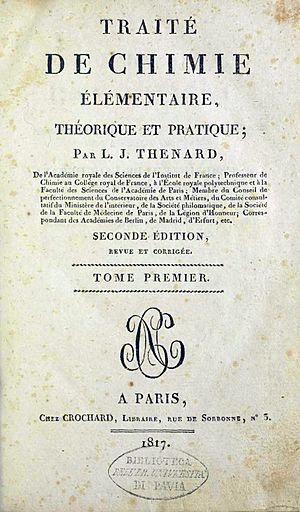Louis Jacques Thénard facts for kids
Quick facts for kids
Louis Jacques Thénard
|
|
|---|---|
 |
|
| Born | 4 May 1777 La Louptière, Champagne (present-day Aube), France
|
| Died | 21 June 1857 (aged 80) Paris, France
|
| Known for | Disovery of Hydrogen peroxide Co-discovery of boron Brin process Thénard's blue |
| Awards | ForMemRS (1824) Galvanism Prize (1809) |
| Scientific career | |
| Fields | Chemistry |
| Doctoral advisor | Louis Nicolas Vauquelin |
Louis Jacques Thénard (born May 4, 1777 – died June 21, 1857) was an important French chemist. He made many discoveries and was also a great teacher.
About His Life
Louis Jacques Thénard was born in a small farm cottage. This was near a town called Nogent-sur-Seine in the Champagne area of France. His father was a farm worker.
After the French Revolution, many boys could get scholarships for school. This allowed Louis to study at an academy in Sens until he was 14. When he was sixteen, he moved to Paris to study pharmacy.
In Paris, he went to lectures by famous chemists. These included Antoine François Fourcroy and Louis Nicolas Vauquelin. Vauquelin was very impressed with Thénard's quick learning. He even let Thénard work in his lab for free. This was special because most students had to pay a fee. Thénard learned so fast that he soon helped teach others. In 1797, he became a chemistry teacher. By 1798, he was a tutor at the famous École Polytechnique.
His Career and Influence
In 1804, Thénard became a professor at the Collège de France. His former teacher, Vauquelin, helped him get this job. Six years later, Thénard also became a chemistry professor at the École Polytechnique and the Faculté des Sciences. He also joined the French Academy of Sciences.
Thénard received many honors during his life. In 1821, he became a foreign member of the Royal Swedish Academy of Sciences. The King of France, Charles X, made him a baron in 1825. Later, in 1832, Louis Philippe made him a peer of France. This meant he was a member of the French Parliament.
From 1827 to 1830, he represented his home region in the French Parliament. He also had a big impact on science education in France. Thénard died in Paris on June 21, 1857. A statue was built to honor him in Sens in 1861. In 1865, his home village was renamed La Louptière-Thénard to remember him.
Thénard was known as an amazing teacher. He believed that everything, including the lab, should be for the students. He wrote a chemistry textbook called Traité de chimie élémentaire, théorique et pratique. This book was used for 25 years and helped chemistry grow a lot.
His Discoveries
Soon after becoming a tutor at the École Polytechnique, Thénard became good friends with Joseph Louis Gay-Lussac. They worked together on many science projects.
Thénard carefully studied metallic oxides. He also showed that a substance called "zoonic acid" was actually impure acetic acid. Because of his smart work, he was invited to join the Society of Arcueil, a group of important scientists.
In 1806, he studied a space rock called the Alais meteorite. This was the first time a special type of meteorite, called a carbonaceous chondrite, was found. Thénard discovered it had a high amount of carbon.
His first scientific paper was in 1799. It was about compounds of arsenic and antimony with oxygen and sulphur. In 1807, he started important research on ethers. He also studied sebacic acid in 1802 and bile in 1807.
One of his most famous discoveries was hydrogen peroxide in 1818. In 1799, he also created a blue pigment. This blue color is now known as Thénard's blue. He made it after being asked to find a cheap coloring material.
His name is one of the 72 names written on the Eiffel Tower in Paris.
Works
See also
 In Spanish: Louis Jacques Thénard para niños
In Spanish: Louis Jacques Thénard para niños
- Phosphorus trichloride
- Thénardite


